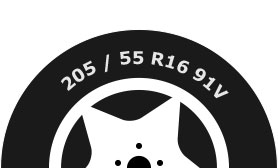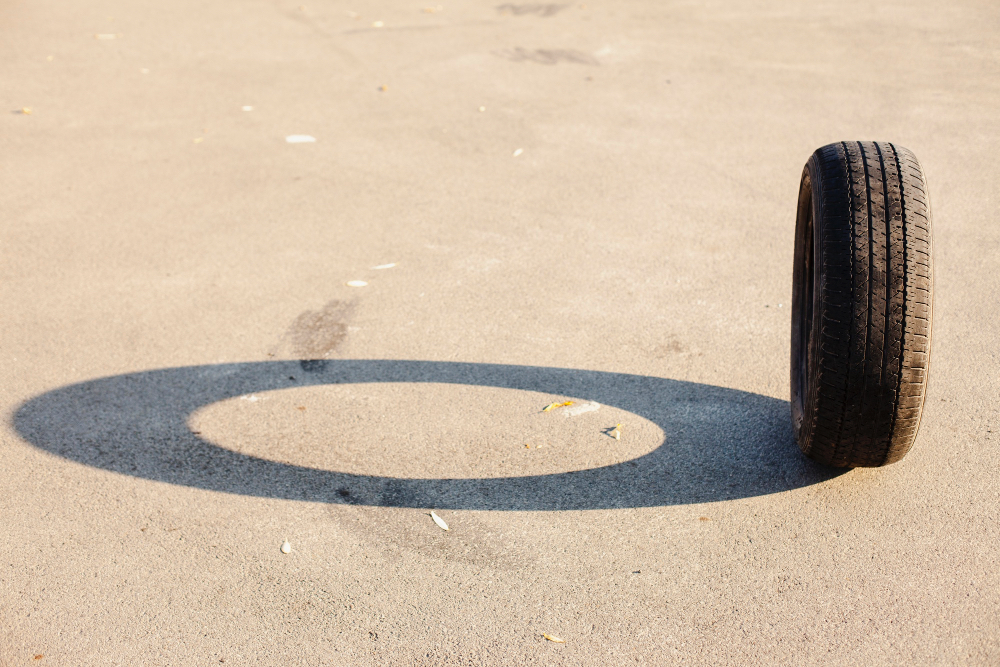Tyres are an essential part of your vehicle: they connect you to the road and have a direct impact on safety, comfort and performance. To help you choose and maintain your tyres with confidence, we have compiled this FAQ on tyres. Here you will find answers to the most common questions about purchasing, maintaining and understanding your tyres.
Introduction
Example of a tyre sidewall

Tyre purchase
What should I check when buying tyres?
Always check the size and specifications of your current tyres before ordering new ones. Look at the markings on the sidewall of the tyre, such as 205/55 R16 91V:
- 205 = Tyre width in millimetres
- 55 = aspect ratio (height/width)
- R = radial construction
- 16 = rim diameter in inches
- 91 = load index
- V = speed index
Why might the tyre size specified in my vehicle documents differ from the size of the tyres fitted?
It is common for the size indicated in the registration documents to differ from that of the tyres actually fitted, particularly if replacement rims have been installed. Always check the tyres currently fitted to your vehicle.
Tyre load index
What does the load index mean?
The load index is a number that indicates the weight a tyre can safely carry under ideal conditions (correct air pressure, appropriate speed).
How can you determine the correct load index?
The load index must be at least equal to the value specified in your vehicle’s documentation. It is possible and sometimes recommended for safety reasons to choose a higher load index.
Why is tyre pressure important for load capacity?
The load capacity of a tyre is only guaranteed when it is inflated to the recommended pressure. Insufficient pressure, combined with high speeds, reduces load capacity and can lead to faster wear or dangerous damage to the tyre.
Load index
88
89
90
91
92
93
94
95
96
97
98
99
100
101
102
103
104
105
Tyre load capacity in kilograms
560 kg
580 kg
600 kg
615 kg
630 kg
650 kg
670 kg
690 kg
710 kg
730 kg
750 kg
775 kg
800 kg
825 kg
850 kg
875 kg
900 kg
925 kg
Tyre speed index
What is the speed index?
The speed rating (also known as the speed symbol) is a letter printed on the sidewall of the tyre that indicates the maximum safe speed for the tyre, provided it is correctly inflated.
Symbole
P
Q
R
S
T
H
V
W
Y
Can I use a speed rating higher than the one specified?
Yes, you can always use a tyre with a speed rating higher than that required by your vehicle.
Vitesse maximale
150 km/h
160 km/h
170 km/h
180 km/h
190 km/h
210 km/h
240 km/h
270 km/h
300 km/h
Can I use a lower speed rating?
In most cases, no. However, there are exceptions for winter tyres and all-season tyres. In such cases, a lower speed rating may be permitted, but the vehicle must be fitted with a sticker indicating the maximum speed permitted for these tyres.
Age of tyres
How old can a tyre be?
Technically, a tyre is considered ‘new’ for up to three years after manufacture, provided it has been stored correctly.
How can I check the age of a tyre?
The DOT code on the sidewall of the tyre indicates the date of manufacture. The last four digits indicate the week and year of manufacture (e.g. 2319 = week 23, 2019).
Is there a legal limit on the age of tyres?
There is no general legal obligation in France regarding the replacement of tyres after a certain number of years. However, many experts recommend replacing them after a maximum of 10 years, regardless of tread depth, due to the ageing of the rubber.
What does ‘new’ mean when buying tyres online?
Unless otherwise specified, many retailers define tyres less than 36 months old as ‘new’. If the exact DOT code is not provided, the stock may consist of mixed production batches.
Additional glossary (quick references)

- DOT number: date of manufacture of the tyre, indicated in week/year format.
- Tread depth: minimum légal en France: 1,6 mm (recommandé: 3 à 4 mm pour plus de sécurité).
- Rolling resistance: influe sur la consommation de carburant; une résistance plus faible = une meilleure efficacité.
- European tyre label: Standardised label indicating wet grip, rolling resistance and noise level.
- Inspection regularly inspect tyres for cracks, bulges, or cuts.
- Check the pressure your tyres at least once a month.
